|
|
|
|
| Missing In Action (MIA) | Prisoners Of War (POW) | Unexploded Ordnance (UXO) |
| Chronology | Locations | Aircraft | Ships | Submit Info | How You Can Help | Donate |
|
 by Peter Scott Hikoki Publications 1999 Soft cover 300 pages Index, photos ISBN: 1902109554 Cover Price: $24.95 Language: English Order now at amazon.com Return to |
Emblems of the Rising Sun Imperial Japanese Army Air Force Unit Markings 1939-1945 Comparatively little is published in English about Japanese Army Air Force (JAAF) aircraft markings. This book is an outstanding publication in terms of quality, research and scope that anyone interested in JAAF aviation should add to their library. The book begins with well written introduction that explores the history of markings of the JAAF, including features like Hinomaru (rising sun / national markings), tail numbers, composition of units and touching on related topics like camouflage and special attack units (kamikaze). This section is followed by a flow chart / order of battle for the JAAF showing the break-down of various units and the theaters they served, airfield locations and aircraft types operated. The bulk of the book is a visual reference spanning each Sentai (regiment). Each is represented with four color plates, showing the representative tail of the particular aircraft type operated, and the markings for each Chutai (company) and Hombu (Headquarters). Like all Air Forces of the war, the tail markings are varied and fascinating to study, some simple others complicated or stylistically interesting, like the use of Ronin symbol (of freelance samurai) by some squadrons, clever motifs like the boomerang tails of the 248th Sentai indicating 2-4-8. The next section of the book shows a representative aircraft from each Sentai in a full, side-view lithograph, with notes about its history and markings. These lithographs are some of the most accurate side-views I have ever seen, not only in terms of their quality, but also in their attention to detail and color - for instance, indications of faded 'red' colors from tropical exposure and repairs. What is so interested about these color plates is that they were created off real wartime photographs, and notations made about their history in the profiles. The last section of the book is a collection of WWII B&W photos of many of the same aircraft illustrated in the profiles, or detailed views highlighting personal markings or other features The book concludes with a helpful glossary for English / Japanese marking terminology. Deep bows to the author for superb research and a beautiful, full color book that fills a void of knowledge about JAAF aircraft of World War II. Review by Justin Taylan To be honest, I had noticed this lonely book in a dusty corner of the Australian War Memorial’s book shop on numerous occasions. I would pick it up, look at the price tag and then put it back down (I thought $55 was too expensive at the time). Eventually, after some months of debate, I decided to go and buy it. It was not until I got home, I realized how important this book would be in my personal library. Japanese aircraft as a whole have never been my strong suit – let alone markings of the various IJAAF units. I had never really had an interest in the Japanese Army Air Force until visiting Precision Aerospace’s restoration of two Ki-61 Tonys at Wangaratta, Australia. (The first thing I did with this book was study the markings of 68th Sentai Tonys). Though a relatively small reference book, this volume includes literally hundreds of diagrams of the various markings of known IJAAF units. Another section devoted to colour profiles of whole aircraft and another dedicated to unpublished black and white photos are also valuable parts of this book. It also includes a small section devoted to explaining the structure of the IJAAF as well as Japanese-English translations. I have found this book particularly useful when creating textures for Japanese aircraft in numerous computer flight simulators. I recommend this book for any model builders out there, as well as anyone interested in one of the most important – yet least documented – air services of the Pacific theatre of the Second World War. Review by Daniel Leahy Return to Book Reviews | Add a review or submit for review Last Updated |
| Discussion Forum | Daily Updates | Reviews | Museums | Interviews & Oral Histories |
|